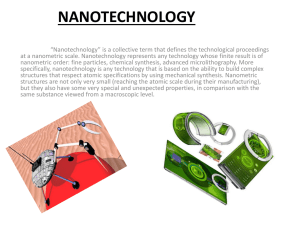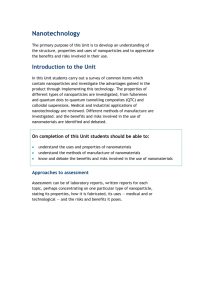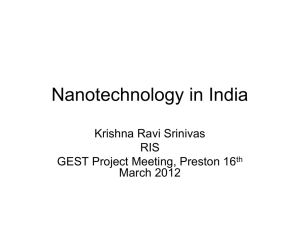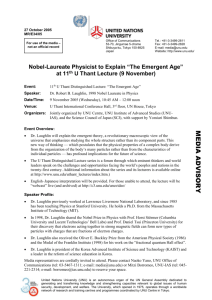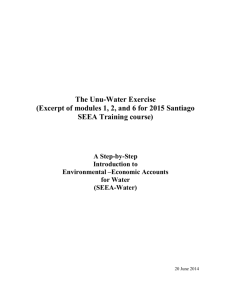Nanotechnology Environmental and Health hazards
advertisement
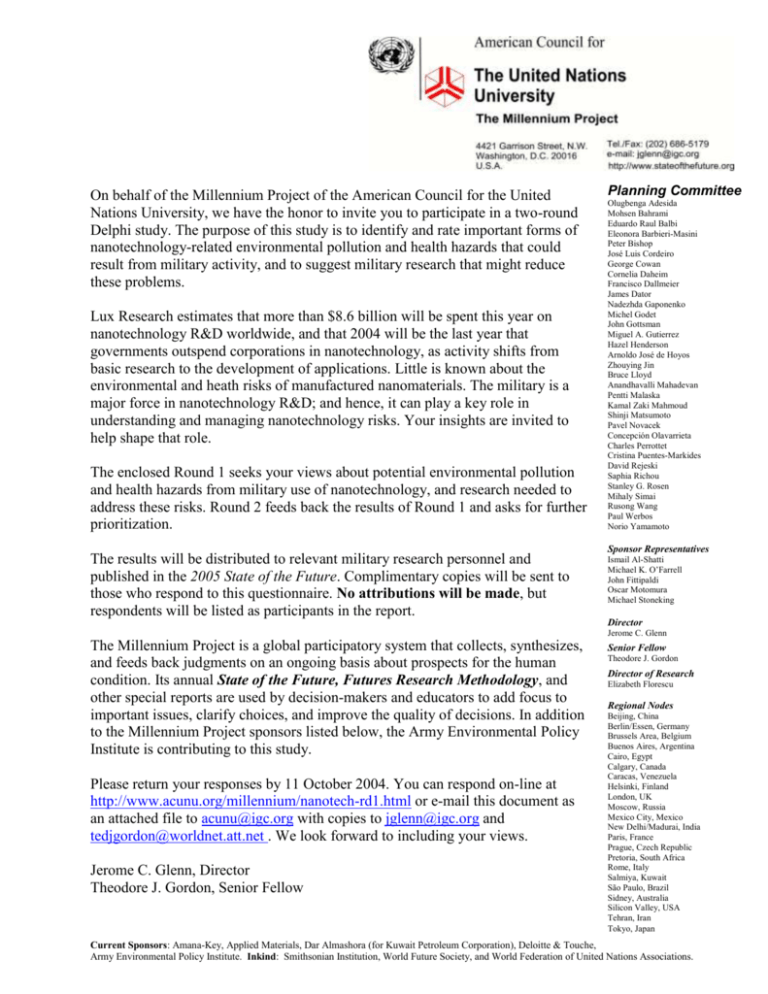
On behalf of the Millennium Project of the American Council for the United Nations University, we have the honor to invite you to participate in a two-round Delphi study. The purpose of this study is to identify and rate important forms of nanotechnology-related environmental pollution and health hazards that could result from military activity, and to suggest military research that might reduce these problems. Lux Research estimates that more than $8.6 billion will be spent this year on nanotechnology R&D worldwide, and that 2004 will be the last year that governments outspend corporations in nanotechnology, as activity shifts from basic research to the development of applications. Little is known about the environmental and heath risks of manufactured nanomaterials. The military is a major force in nanotechnology R&D; and hence, it can play a key role in understanding and managing nanotechnology risks. Your insights are invited to help shape that role. The enclosed Round 1 seeks your views about potential environmental pollution and health hazards from military use of nanotechnology, and research needed to address these risks. Round 2 feeds back the results of Round 1 and asks for further prioritization. The results will be distributed to relevant military research personnel and published in the 2005 State of the Future. Complimentary copies will be sent to those who respond to this questionnaire. No attributions will be made, but respondents will be listed as participants in the report. Planning Committee Olugbenga Adesida Mohsen Bahrami Eduardo Raul Balbi Eleonora Barbieri-Masini Peter Bishop José Luis Cordeiro George Cowan Cornelia Daheim Francisco Dallmeier James Dator Nadezhda Gaponenko Michel Godet John Gottsman Miguel A. Gutierrez Hazel Henderson Arnoldo José de Hoyos Zhouying Jin Bruce Lloyd Anandhavalli Mahadevan Pentti Malaska Kamal Zaki Mahmoud Shinji Matsumoto Pavel Novacek Concepción Olavarrieta Charles Perrottet Cristina Puentes-Markides David Rejeski Saphia Richou Stanley G. Rosen Mihaly Simai Rusong Wang Paul Werbos Norio Yamamoto Sponsor Representatives Ismail Al-Shatti Michael K. O’Farrell John Fittipaldi Oscar Motomura Michael Stoneking Director Jerome C. Glenn The Millennium Project is a global participatory system that collects, synthesizes, and feeds back judgments on an ongoing basis about prospects for the human condition. Its annual State of the Future, Futures Research Methodology, and other special reports are used by decision-makers and educators to add focus to important issues, clarify choices, and improve the quality of decisions. In addition to the Millennium Project sponsors listed below, the Army Environmental Policy Institute is contributing to this study. Please return your responses by 11 October 2004. You can respond on-line at http://www.acunu.org/millennium/nanotech-rd1.html or e-mail this document as an attached file to acunu@igc.org with copies to jglenn@igc.org and tedjgordon@worldnet.att.net . We look forward to including your views. Jerome C. Glenn, Director Theodore J. Gordon, Senior Fellow Senior Fellow Theodore J. Gordon Director of Research Elizabeth Florescu Regional Nodes Beijing, China Berlin/Essen, Germany Brussels Area, Belgium Buenos Aires, Argentina Cairo, Egypt Calgary, Canada Caracas, Venezuela Helsinki, Finland London, UK Moscow, Russia Mexico City, Mexico New Delhi/Madurai, India Paris, France Prague, Czech Republic Pretoria, South Africa Rome, Italy Salmiya, Kuwait São Paulo, Brazil Sidney, Australia Silicon Valley, USA Tehran, Iran Tokyo, Japan Current Sponsors: Amana-Key, Applied Materials, Dar Almashora (for Kuwait Petroleum Corporation), Deloitte & Touche, Army Environmental Policy Institute. Inkind: Smithsonian Institution, World Future Society, and World Federation of United Nations Associations. AC/UNU Millennium Project www.acunu.org AC/UNU Millennium Project Environmental Pollution and Health Hazards Resulting From Military Uses of Nanotechnology Round 1 The US National Science Foundation allocated US$30 million in FY 2002 for studies of environmental and health impacts of nanotechnology. In 2003 the European Union funded the NANOSAFT project to assess the technology’s environmental and health risks. In July 2003 the US EPA invited proposals to study environmental and health impacts of nanotechnology. As you address the questions below, please give special attention to research needs beyond these ongoing studies, specifically those that should be conducted by the military. Your input is welcome on the full range of nanotechnologies of the present and future from nanobulk-process nano (simple structures), top-down nano (low-volume production), and nanobuilt nano (high-volume, low-cost, complex high-performance components -- and even whole products). For the purposes of this study, the definition of Vicki L. Colvin of Rice University is used to define engineered nanomaterials as "inorganic materials of high uniformity, with at least one critical dimension below 100 nm, specifically engineered for applications." Also included in this study are structural materials made of nanotubes of all kinds -- carbon, carbon-silicon, and other materials, plus "metamaterials" -- nanopatterned bulk materials with unique electromagnetic properties due to nanostructuring and other manufactured nanoparticles, as well as productive nanosystems and their products. Round 1 asks the three questions: What environmental pollution and health hazards might result from military uses of nanotechnology in the time periods 2005-2010 and 2010-2025? How likely is it that research questions/projects listed below, if pursued would generate critical knowledge for the prevention or reduction of future nanotech environmental pollution and health hazards? What other research questions/projects should be added, taking into account your answers to question 1? What additional major ongoing or planned studies should be added to the given list of five overview studies to help understand the priorities in addressing these questions? You need not answer every question; only those about which you have expertise. AC/UNU Millennium Project Nanotech pollution/hazard Study 1 AC/UNU Millennium Project www.acunu.org Question 1: What important environmental pollution and health hazards might result from military uses of nanomaterials? Importance is defined as potentially affecting large numbers of people in potentially irreversible ways. 1.1 Between 2005 and 2010 (two examples are provided) Military Use 2005-2010 Nanomaterials in sun screens, camouflage creams, and/or bioweapons skin shields Nanomaterials (e.g., nanotubes) in uniforms and equipment to make them stronger and lighter. Environmental or Health Impact Absorption of nanoparticles through the skin and/or flushed into the environment and entering the food chain Nanofiber-like materials that break off from uniforms and equipment that enter the body and environment. 1.2 Between 2010-2025 (two examples are provided) Military Use 2010-2025 Nanoscale sensors Artificial blood cells (respirocytes) dramatically enhance human performance Environmental or Health Impacts Litter the environment, concentrating in water and soil and eventually linking with natural organisms, causing unknown environmental changes. Cause overheating of the body, biobreakdowns, and their excretion causes another environmental load. AC/UNU Millennium Project Nanotech pollution/hazard Study 2 AC/UNU Millennium Project www.acunu.org Question 2: The military is improving uniforms, equipment, weapons, and energy and intelligence systems with nanotech materials. As these are discarded, lost, damaged, and/or altered by use, it is reasonable to assume that nanomaterials may enter the human body and the environment. Your judgment is sought about the research potential posed by the questions below; that is, whether their pursuit is likely to produce knowledge that will lead to the prevention or reduction of potential nanotech environmental pollution and health hazards. Please use the following scale: Potential for gaining new knowledge from the research 5 = Will lead to critical knowledge for preventing and/or reducing problems 4 = Very likely to lead to critical knowledge for preventing and/or reducing problems 3 = May lead to critical knowledge for preventing and/or reducing problems 2 = Not likely to lead to critical knowledge for preventing and/or reducing problems 1 = A complete waste of time Space is provided at the end of each list to add other research questions and/or rephrase any of the given items. 2.1 Health hazard research questions Research Potential 2.1.1 How are nanoparticles absorbed into the body through the skin, lungs, eyes, ears, and alimentary canal? 2.1.2 Once in the body, can nanoparticles evade natural defenses of humans and other animals? 2.1.3 How are they distributed throughout the body? 2.1.4 What is unique about the health hazards of manufactured nanomaterials vs. health hazards of particles of a similar size? 2.1.5 What are the important unknowns about nanomaterials passing the brain/blood barriers and transversing neural pathways? 2.1.6 How are nanomaterials metabolized and eliminated by the body? 2.1.7 What is the nature and quantitative effectiveness of the mechanism for removing nanoparticles from the lungs? 2.1.8 Can nanomaterials concentrate inside humans? If so, in which organs are they most likely to accumulate? 2.1.9 Can nanoparticles enter egg and sperm cells altering DNA? 2.1.10 What are the surface properties of nanoparticles that alter toxicity? Please suggest other key research questions related to health hazards and/or rephrase those above: AC/UNU Millennium Project Nanotech pollution/hazard Study 3 AC/UNU Millennium Project www.acunu.org 2.2 Environmental Pollution research questions Research Potential 2.2.1 How to identify and dispose of nanomaterial litter? 2.2.2 Do nanoparticles act like bioaccumulants in Nature? 2.2.3 How biodegradable are nanotube-based structures? 2.2.4 How might nanoparticles get into plants and other organisms? 2.2.5 Could nanoparticles enter the food chain by getting into bacteria and protozoa and accumulate there? 2.2.6 What are the potential environmental impacts of nanotech water purification systems? 2.2.7 How can nanotechnology be used for post-battlefield cleanup (including biological, chemical, and nuclear wastes) so that they do not pollute soil and water? 2.2.8 What strategies could prevent the “gray goo” problem? Please suggest other key research questions related to environmental pollution and/or rephrase those above: 2.3 General questions about addressing environmental and health issues of future nanomaterials Research Potential 2.3.1 How can standard metrics for nanotech pollution/hazards be developed? 2.3.2 What are the most useful methodologies and protocols for environmental pollution and health hazard studies for the range of nanotechnologies? 2.3.3 What is a useful classification system to provide a framework to make research judgments and keep track of the state of knowledge about nanotech’s potential pollutions? 2.3.4 How can toxicologists and pharmaceutical scientists investigating nano particles ability to evade cell defenses to target disease be best brought together? 2.3.5 What training will be necessary to provide the capacity for oversight for safer development and application of nanotechnology? 2.3.6 How can nano-built nanoproducts intensify earlier problems of nanomaterials and create important new ones? 2.3.7 How can arms-control measures prevent the deployment of powerful nanomanufacturing systems able to produce unprecedented quantities of advanced weapons? 2.3.8 How can stand-off off-switches be created to deactivate nanotech weapons? Please suggest other general research questions related to environmental pollution or health hazards and/or rephrase those above: AC/UNU Millennium Project Nanotech pollution/hazard Study 4 AC/UNU Millennium Project www.acunu.org Question 3: Please list additional major studies in addition to those listed below and, if possible, provide a sentence or two describing the thrust of the work. Nanoscience and Nanotechnologies: Opportunities and Uncertainties. Royal Society and the Royal Academy of Engineering, July 2004 http://www.nanotec.org.uk/finalReport.htm Overview of Completed and Ongoing Actives in the Field: Safety and Risks of Nanotechnology, Version 2.1, Technologie Management, Switzerland (a survey of surveys.) June 10, 2004. http://www.temas.ch/WWWTEMAS/TEMAS_Homepage.nsf/vwRes/Safety/$FILE/NANOSafety_Versio n2_1.pdf Vicki L. Colvin. The Potential Impact of Engineered Nanomaterials, Nature Biotechnology, Nature Publishing Group, 21, No. 10, October 2003, 1166-70 From Genomes to Atoms: The Big Down: Atomtech: Technologies Converging at the Nano Scale, The ETC Group, January 2003. http://www.etcgroup.org/documents/TheBigDown.pdf The Nanotech Report 2004, Lux Research, New York 2004 http://www.luxresearchinc.com/tnr2004 Nanotechnology: Small Matter, Many Unknowns, Swiss Reinsurance Company. Zurich, Switzerland, 2004. http://www.swissre.com/INTERNET/pwswpspr.nsf/fmBookMarkFrameSet?ReadForm&BM=../vwAllbyI DKeyLu/ULUR-5YAFFS?OpenDocment Jürgen Altman and Mark Gubrud, Risks from Military Uses of Nanotechnolog. 2002 http://www.ep3.ruhr-uni-bochum.de/bvp/RiskMilNT_Lecce.pdf Tom McCarthy, World Systems http://www.mccarthy.cx/WorldSystem/war.htm Center for Responsible Nanotechnology, The Effects of Molecular Manufacturing on Military and Government Capability and Planning. http://www.crnano.org/study20.htm. What additional major ongoing or planned studies should be added to the list above to help understand the priorities in addressing these questions? Thank you very much for your participation. The results will be put into Round 2 and made available to you in mid-November 2004. AC/UNU Millennium Project Nanotech pollution/hazard Study 5




